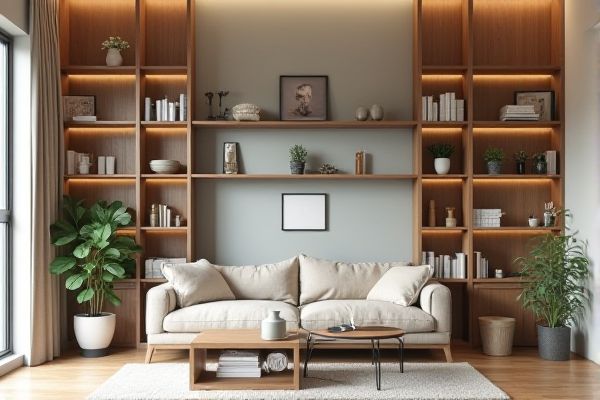
Floor-to-ceiling shelves maximize vertical storage space, offering a sleek, continuous look ideal for small rooms or minimalist designs. Partial height shelves provide flexible storage options and easier access while allowing wall space for artwork or windows; discover which shelving style best suits Your space and needs by reading the rest of the article.
Table of Comparison
| Feature | Floor to Ceiling Shelves | Partial Height Shelves |
|---|---|---|
| Storage Capacity | Maximum vertical space utilization | Limited to mid-wall height |
| Accessibility | Requires step stool for upper shelves | Easily reachable without aids |
| Design Impact | Creates an expansive, built-in look | Offers a balanced wall design |
| Installation Complexity | More complex, may need professional help | Simpler and quicker to install |
| Cost | Higher due to materials and labor | Lower overall cost |
| Customization | Highly customizable for maximum storage | Limited customization options |
| Room Impact | Can make a room feel taller and more spacious | Maintains standard room proportions |
Introduction: Floor to Ceiling Shelves vs Partial Height Shelves
Floor to ceiling shelves maximize vertical storage space by utilizing entire wall heights, ideal for rooms with high ceilings and limited floor area. Partial height shelves offer flexible storage options, allowing for decorative displays above and accessible storage below, often enhancing visual openness in smaller spaces. Choosing between these depends on room dimensions, storage needs, and aesthetic preferences.
Space Optimization: Maximizing Storage Efficiency
Floor-to-ceiling shelves maximize vertical space by utilizing the entire wall height, significantly increasing storage capacity and reducing clutter in small rooms. Partial height shelves offer easier accessibility and flexibility for decorating but sacrifice potential storage volume compared to full-height units. For optimal space optimization, floor-to-ceiling shelves are ideal in maximizing storage efficiency, especially in compact living areas.
Aesthetic Impact: Visual Appeal and Design Harmony
Floor-to-ceiling shelves create a striking visual impact by emphasizing vertical space and offering a cohesive, symmetrical design that enhances room height and grandeur. Partial height shelves introduce varied layering that adds dynamic texture and flexibility, allowing for integrated decorative elements and furniture placement that complement overall aesthetics. Choosing between them depends on balancing room proportions and desired ambiance to achieve harmonious design integration.
Accessibility: Convenience and Ease of Use
Floor-to-ceiling shelves maximize storage space but may limit accessibility to higher sections without a step stool or ladder, making frequent access less convenient. Partial height shelves offer easier reachability for everyday items, enhancing your convenience and ease of use without additional tools. Choosing between the two depends on your need for storage capacity versus effortless accessibility.
Versatility: Adaptability to Different Room Types
Floor-to-ceiling shelves offer maximum storage capacity and create a seamless, towering visual impact, ideal for spacious living rooms or libraries needing extensive organization. Partial height shelves provide versatility in smaller rooms or multifunctional spaces, allowing for additional wall decor or furniture placement above them. Your choice depends on balancing storage needs with room functionality, as floor-to-ceiling options suit more open areas while partial shelves adapt better to varied interior layouts.
Installation and Structural Considerations
Floor-to-ceiling shelves require precise measurement and secure anchoring into wall studs to ensure stability and support the full height load, making installation more complex and time-consuming. Partial height shelves allow for easier installation with fewer structural reinforcements since they bear less vertical stress and can sometimes rest on existing furniture or baseboards. Structural considerations include assessing wall integrity for floor-to-ceiling units and the potential need for additional brackets or supports in partial height options to maintain durability and safety.
Cost Comparison: Budgeting for Each Option
Floor to ceiling shelves generally involve higher material and installation costs due to increased use of lumber or metal, as well as the need for professional labor to ensure structural stability. Partial height shelves tend to be more budget-friendly, requiring fewer materials and allowing for easier DIY assembly, which reduces overall expenditure. When budgeting, it's essential to factor in not only initial costs but also potential customization, maintenance, and the added value floor to ceiling shelves provide in maximizing vertical storage space.
Maintenance and Cleaning Requirements
Floor to ceiling shelves require more extensive maintenance and cleaning due to their larger surface area and difficult-to-reach upper sections, often necessitating the use of ladders or specialized cleaning tools. Partial height shelves are easier to maintain and clean as all areas are accessible without extra equipment, reducing the time and effort needed for dusting and wiping. Regular upkeep of floor to ceiling shelves is essential to prevent dust accumulation in less accessible spots, while partial height shelves facilitate quicker and more efficient cleaning routines.
Safety and Stability Factors
Floor to ceiling shelves offer enhanced safety and stability due to their anchored design, reducing the risk of tipping over, especially in homes with children or pets. Partial height shelves may require additional wall fixing to ensure stability and can be less secure under heavy loads or seismic activity. Your choice should consider secure installation methods and the weight capacity needed to maintain a safe environment.
Choosing the Right Shelving: Key Decision Criteria
Floor-to-ceiling shelves maximize vertical storage space, ideal for rooms with high ceilings and extensive storage needs, while partial height shelves offer flexibility and easier access in smaller spaces or for frequently used items. Consider ceiling height, room layout, and the type of items you plan to store when deciding between these options. Your choice should balance aesthetics, functionality, and ease of maintenance to create an efficient and visually pleasing storage solution.
 homyna.com
homyna.com